#agricultural treasures
Text
Summer Travel Essentials 2024
With the passing of Memorial Day, the 2024 Summer travel season is upon us! Do you have certain things that make your summer travel better? I know I do! I am sharing some of my favorite tips and summer essentials finds!
A Book in hand.
This is a repeated phrase of mine, but I have to have a book when on the road. Whether to read while riding along, or before bed, I always bring a read along.…
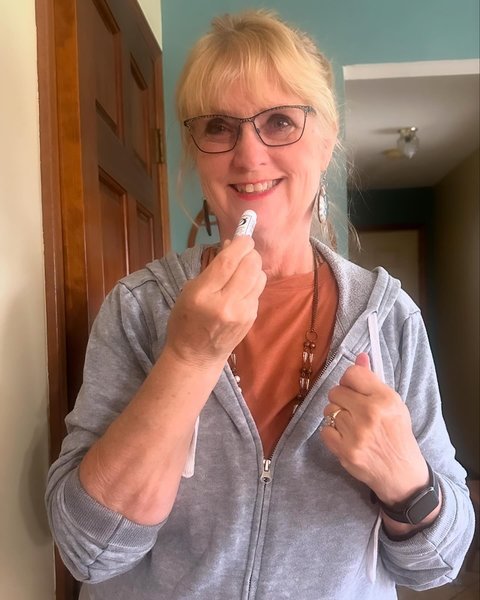
View On WordPress
#2024#agricultural treasures#Agricultural Treasures Guidebook#AJ&039;s Garden Tractor Jambore#Andy Hinrichs#bar conditioner#bar shampoo#Bathhouse Soapery#big brimmed hat#body butter#book#Clarksdale Mississippi#collectibles#Collective Seed and Supply Co.#comfortable clothes#David Satka#Dr. Motion compression socks#events#festivals#Flea markets#Gardenia#hikeing#historic sites#Home Goods#improve#independent book stores#JR Liggetts#library#Lincoln boods#lip butter
0 notes
Text
My theory for what cave-claws are in LotRO is over-evolved earthworms. Worms with spines. The skin on the big ones looks kind of wormy and they canonically eat rocks, kind of like worms eat dirt. They are unfortunately less beneficial to have in your garden than normal earthworms because they bite and have large and sharp teeth.
#lotro#unless of course they are specially trained#like theyre probably still great composters so they theoretically could be a useful agriculture animal#its just the biting#training them is hard and time consuming and mostly done by dwarves#who do farm but are altogether too preoccupied with the effect cave claws have on mines and treasure#which is of course detrimental across the board i bet theyre just terrible for the structural integrity of underground architecture#but because of that the dwarves just dont really consider them in terms of agriculture
18 notes
·
View notes
Text
youtube
#Crabs#tumblr crabs#mental health#health and wellness#love#tourism#youtube#love poetry#birds#music#mountains#agriculture#fish#crab spider#another crabs treasure#hermit crabs#aquatic#sharks#marine biology#hermit crab#ocean#sea#Curry crabs#food#Youtube
0 notes
Text
இந்திய சட்டங்கள் மற்றும் இந்தியாவில் சட்டப்பூர்வ தீர்வுகள்
இந்தியா வளமான கலாச்சார பாரம்பரியம் கொண்ட பல்வேறு நாடு. இந்திய சட்ட அமைப்பு உலகின் பழமையான சட்ட அமைப்புகளில் ஒன்றாகும், மேலும் இது பல ஆண்டுகளாக உருவாகி வருகிறது. குடிமக்களின் உரிமைகளைப் பாதுகாக்கவும் நீதியை உறுதிப்படுத்தவும் இந்தியாவில் பல்வேறு சட்டங்கள் மற்றும் சட்டப் பரிகாரங்கள் உள்ளன.
இந்திய சட்டங்கள்
இந்திய சட்ட அமைப்பு இந்தியாவில் வாழ்க்கையின் பல்வேறு அம்சங்களை ஒழுங்குபடுத்துவதற்கும்…

View On WordPress
#The Acquired Territories (Merger) Act 1960#The Additional Duties Of Excise (Textiles And Textile Articles) Act 1978#The Administration of Evacuee Property (Central) Rules1950#The Administration of Evacuee Property Act 1950#The Advocates Welfare Fund Act 2001#The African Development bank Act 1983 The Banking Regulation Act 1949#The Agricultural And Processed Food Products Export Development Authority Act 1985#The Agriculturists Loans Act 1884#The Airports Economic Regulatory Authority Of India Act 2008#The All India Council For Technical Education 1987#The All India Institute Of Medical Science Act 1956#The Anand Marriage Act 1909#The Ancient Monuments and Archaeological Sites and Remains Act 1958#The Ancient Monuments Preservation Act 1904#The Anti-Hijacking Act 1982#The Antiquities and Art Treasures Act 1972#The Architects Act 1972#The Arms Act 1959#The Arya Marriage Validation Act 1937#The Banking Regulation (Amendment) and Miscellaneous Provisions Act 2004#The Benami Transactions(Prohibitions) Act 1988#The Biological Diversity Act 2002#The Cantonments Act 2006#The Carriage By Air Act 1972#The Carriage by Road Act 2007#The Cencus Act 1948#The Central Boards Of Revenue Act 1963#The Central Excise Act 1944#The Central Reserve Poilce Force 1949#The Central Road Fund Act 2000
0 notes
Note
I wanna know EVERYTHING about the social structure of those snail dudes
The atlanteans are the strain, there are two big atlantean cultures. The Continentals, and the Lwes-Atalan.
It was originally one empire that split in half along the Mesonerian sea. The easterners are the older part of the empire, characterized by being an old aristocratic military and agricultural power. The Lwes-Atalan are the newer group, they're characterized as being merchants and bankers. Both groups are famous for being mercenaries. The stereotypical atlantean is a mercenary. You can tell which emotion they're from by how foppishly they're dressed. The lwes-atalan tend to be much more ostentatious.
Lwes-Atalan is less a country and more 15 noble merchant clans that have been beefing with each other for 300 years. Each has their own island chain in the Mesian sea, and generally speaking each of the Noble Families controls a particular trade within the empire. For example, the De Troziers are bankers and goldsmiths.
They're obsessed with Nobility. But the thing is, damn near every Lwes-Atalan is some kind of nobility. Their landed gentry has intermarried so much that they've ended up with a bizarre sort of mercantile Monarcho-Socialism in which technically everyone gets dividends from the treasure ships, so being a farmworker is almost a religious position.
You know how the Italians will strangle you if you don't make pizza with tomatoes that come from some specific valley where they've been growing pizza tomatoes for eight thousand years? That's what Atlantean religion is like. Exploiting your peasantry isn't just threatening the sense of national identity, it's sacrilege. If your peasant union complains about you enough, the clam pope gets to ritually execute you.
502 notes
·
View notes
Text
~ Headcanons for twst characters playing Minecraft.
Another parts about:
Idia and Malleus!
Riddle and Leona!
Jade and Floyd!
[Azul]
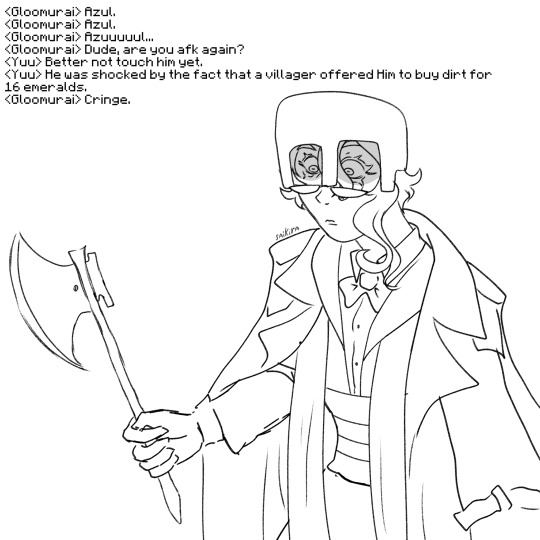
Headcanon, what if Idia and Yuu somehow convinced Him to play minecraft, Azul...:
1) "Why are there cubes everywhere??? I don’t understand anything...."
2) When he learns that monsters are appearing in the dark, he places two stacks of torches around himself in horror.
3) Crying from the physics of trees.
4) Will try to make a copy of Mostro in Minecraft.
5) He does not like to dig in mines and fight, but prefers to engage in agriculture, construction and trade.
6) He built his own village, with a complex hierarchy, its own economy and an underground mafia, where he keeps all the villagers under iron grip.
7) Every five minutes:
<Octo_businessman> fell from a high place.
<Octo_businessman> tried to swim in lava.
<Octo_businessman> was blown up by creeper.
<Octo_businessman> was drowned.
<Octo_businessman> starved to dead.
8) If one of the players hits or kills an squid in front of Him, He will take it as a personal insult.
9) The only one on the server who goes to bed on time and swears at everyone in the chat, because he cannot miss the night while others are awake.
10) Chief of food, armor and potions (Not for free, of course)...
11) Tries to negotiate with the pillagers.
12) Most likely, his house is either a clumsy box decorated with vines and blue flowers, or a huge penthouse with twenty rooms. There is no middle ground. Also, it seems to me that his house would be somewhere on the beach, or in the middle of the lake.
13) Drowned people are his worst enemies.
14) Makes secret chests with all sorts of treasures that he clearly does not intend to share.
15) Already dug up all the gold and ransacked all the treasuries, while the others fought with the ghasts and withers.
16) He comes into the game the least often, because “I actually have my fill of things to do.”
17) He is afraid of dolphins, because he personally knew real ones and knows that they are not the friendliest guys (No, seriously. Dolphins are assholes. Just Google it).
18) Terrible in PVP and always dies first.
19) He says that He doesn’t care about griefers and considers their tricks to be child’s play, but in reality, he is very offended and complains to Yuu in PM on discord.
20) Likes to play in small groups of 2-3 people and does not like to play alone or with too many players.

(A SMALL UPDATE! Previously, this post was dedicated only to Azul, but I decided to make two characters for each post, for beauty, so I'll add another Lilia from the request here.)
[Lilia]
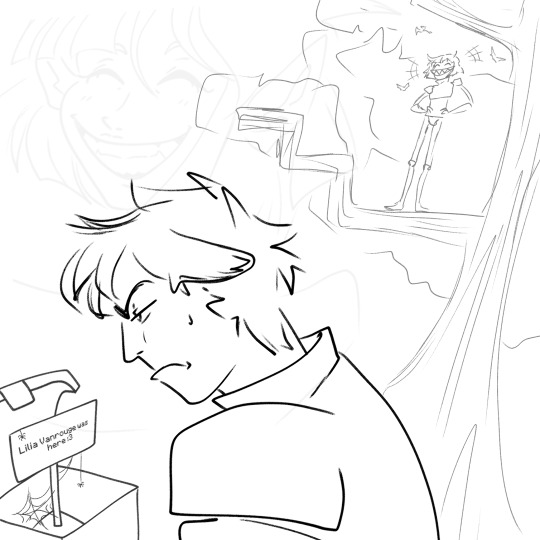
Lilia has been familiar with Minecraft since the game's inception:
1) "Ha-ha, I love adventures!"
2) Competes with Idia, who spends more time in the game and brazenly takes advantage of the fact that fairies do not need sleep as much as people (even the cursed).
3) Daddy's house is either a cave full of vegetation and bats, or there is none at all, since Lilia prefers to roam the entire server. Usually wanders the world on a fast black horse in leather armor painted green, but often runs on His own two feet.
4) He named His horse Samson.
5) He is constantly accompanied by bats.
6) During His adventures, Lily has found many interesting resources and items, and in order not to carry everything with Him, He makes ingenious warehouses with traps, which the entire server covets.
7) Sometimes takes other players on His campaigns. For example, Malleus, Sebek, Silver, Idia and Yuu.
8) Thunderstorm of PVP. Want to fight Him? Good luck.
9) Seriously... You will need luck VERY much.
10) His favorite biomes are forest ones. He hangs out especially often in Taiga and Tundra.
11) The second admin and dad of the server, who suggested Idia the idea of creating a world for the rest of the Twst guys.
12) The most secretive player on the server after Idia. In most cases, He disappears somewhere far, far away, but occasionally, He can be found bargaining with other players, sitting in a tree, or on a campaign. He also likes to play pranks and make fun of other players.
13) For some reason, all the monsters in the area ignore Him, or quickly run away.
14) Collects records (He especially likes "Ward" and "Pigstep").
15) His favorite soundtracks from the game are "One More Day" and "Firebugs".
16) Lilia has already cleared out all the treasures, sunken ships and pyramids, and in order to further annoy other players, He usually leaves signs next to the empty chests saying “Lilia Vanrouge was here :3”
17) Didn’t go to the End because caught flashbacks because of the dragon.
18) Was the one who informed Malleus that a dragon egg cannot be hatched and raise a baby dragon, and without knowing it, he regrets it.
19) Helped Idia find suitable mods for hatching and taming the dragon :D
20) "Silver, bring Your old man a glass bottle of water..."
...And then He goes off to brew an invisibility potion so he can shoo away and banter other players around with an evil giggle.
If you like My post, please reblog Me! :3
Also, if You want a doodle and headcannons for some other twst character, I will be happy to answer Your requests. They are open :D
#art#мой арт#artists on tumblr#memes#twisted wonderland#twst#azul ashengrotto#twst azul#twst memes#twst yuu#twst idia#azul x reader#twisted wonderland azul#azul ashengrotto x yuu#azul ashengrotto x reader#minecraft#twst headcanons#headcanon#reblog me#funny#lilia vanrouge#twst lilia#twisted wonderland lilia#chapter 7#general lilia#lilia headcanons
220 notes
·
View notes
Photo

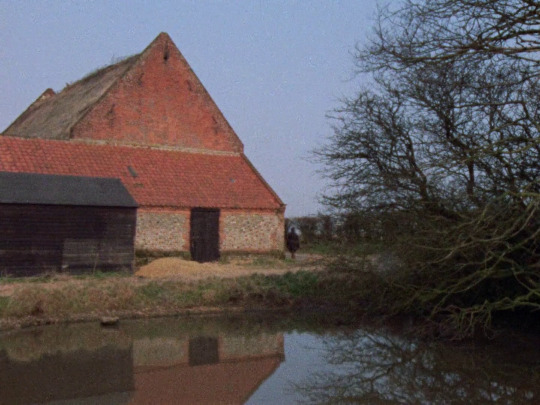
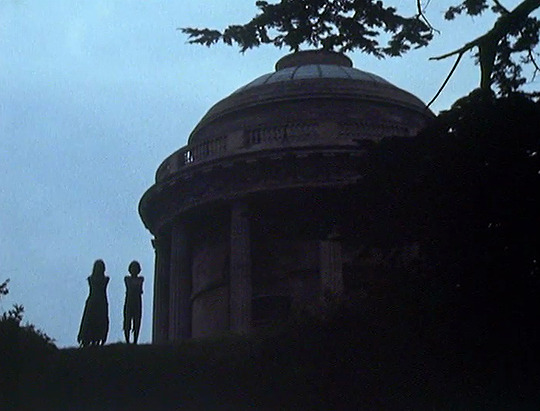

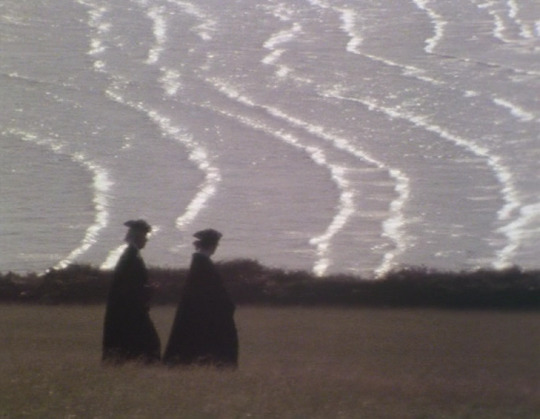
The Stalls of Barchester (Lawrence Gordon Clark, 1971)
A Warning to the Curious (Lawrence Gordon Clark, 1972)
Lost Hearts (Lawrence Gordon Clark, 1973)
The Treasure of Abbot Thomas (Lawrence Gordon Clark, 1974)
The Ash Tree (Lawrence Gordon Clark, 1975)
“For all five of these adaptations, Gordon Clark worked with cinematographer John McGlashan and sound recordist Dick Manton, who he credits with establishing the gloomy look that would be the hallmark of the series (as well as editor Roger Waugh who edited all the original series’ James adaptations save 1973’s ‘Lost Hearts’). Central to that aesthetic were the authentic East Anglian locations that have been the inspiration for many a terror tale, even aside from those of M.R. James.
‘James lived in East Anglia—the region that encompasses Norfolk and Suffolk—for most of his life,’ explains Helen Wheatley, citing this as one reason James set many of his stories there. ‘However, there is also a broader sense of the region as being rather out on a limb, a relative hinterland, which lends itself to ghost story telling,’ she continues. ‘In James’ stories, and their television adaptations, the geography and landscape of the region—expanses of flat land, the whispering grasses of the East Anglian coast line, sparsely populated agricultural land—has a particularly haunting quality.’
This landscape is key to the series’ hauntological appeal. Scholar Derek Johnston has an extensive catalogue of writing that examines nostalgia in relation to the Christmas ghost story—and the A Ghost Story for Christmas series in particular—and notes that the Victorian middle class idealization of rural life was subverted by James’ stories, which presented the country as peaceful on the surface but a place of dark, tumultuous secrets. He also points out that East Anglia is a land of invaders and colonizers, writing in his essay ‘Season, Landscape and Identity in the BBC Ghost Story for Christmas’ that ‘The connection to the local soil and landscape runs generations deep, but it has also been built upon the remains of earlier populations, with earlier connections to that landscape, overrun by the incomers...the landscape may encourage identification with the nation, but it also emphasises how the landscape is interpreted through the history of human action upon it.’” — Kier-La Janisse, from Yuletide Terror: Christmas Horror on Film and Television (2017).
#lawrence gordon clark#kier la janisse#yuletide terror: christmas horror on film and television#w*#caps#mr james christmas
155 notes
·
View notes
Text

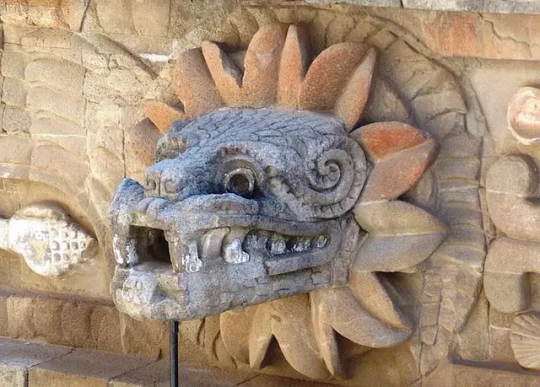
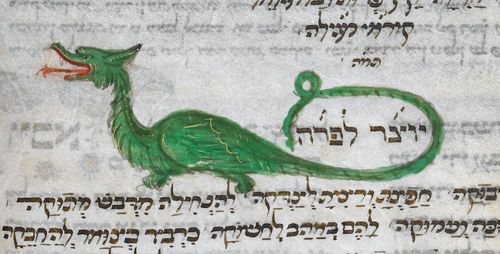
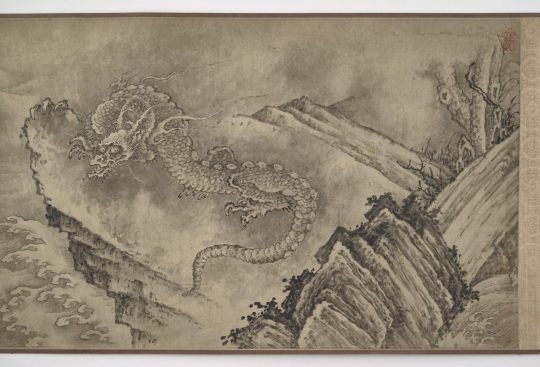

The Dragon Drags On
Though seldom seen today, dragons, of the genus Draconis, are some of the most famous creatures in the world, known for their size, ferocity, elegance, and supposed love for treasure. Though the exact number of dragon species is unknown, there are at least a dozen that are officially recognized; the real number is likely much higher. Once widespread, the range of this group has declined dramatically in the past centuries and populations are now believed to reside in only the most remote parts of the world. Most of what we know of dragons comes from historical records, and study of live specimens has proved impossible due to their rarity.
Because of their global distribution, dragons display a wide variety of morphological traits, including coloration, features, and even the number of limbs. However, some traits are common to nearly all species. Most dragons are thought to be brightly colored, often red, green, or blue; many species also have gold patterns in some form. As reptiles, dragons are covered in scales, though some also posses feathers or manes. Dragons also have extremely long, flexible tails which in some species may act as a supplementary limb. The body is generally long and serpant like, with the exception of the European Dragon and the mushhushshu, or Babylonian dragon. Though all species share an ability to fly, only the European dragon has a functional set of wings. The mechanics of flight for other species are unknown. The European dragon is also noted for its ability to breathe fire; other species such as the Chinese Dragon, or lóng, are more often associated with water.
All dragon species are believed to be carnivorous, though the content of their diet varies from region to region. Due to their large size, it is believed that they predate upon larger mammals such as cattle, sheep, camels, llama, deer, and even megafauna like elephants. Though they lack natural predators, their consistent targeting of livestock and game animals has in the past led dragons into conflict with humans; centuries of dragon hunting for sport and to protect agricultural interest has pushed the dragon to the brink of extinction.
Very little is known about the breeding habits of dragons. Like most large reptiles, they are believed to be solitary and fiercely territorial. It is also likely that they lay eggs, but whether parents provide any kind of care for their clutch or hatchlings is unknown. To date, no record of juvenile dragons has been found, indicating that the rate of survival to adulthood is extremely low. This may be due to predation on hatchlings by opportunistic animals, or adult dragons may attack and kill juveniles to defend their territory, or a combination of the two.
Although they are extremely rare today, dragons have been and continue to be important part of cultures around the world. Ancient civilizations such as the Aztec, Egyptians, and Mesopotamians all revered dragons as dieties. Many other cultures incorporated dragons into their folklore and mythologies, and in many parts of the world the dragon has come to symbolize power, changes in the seasons, or natural disasters, among other things. In more modern times, dragons have come to be associated with wealth, though there is no biological evidence for treasure-hoarding behavior.
Conservation status: Because no dragon species has been sighted for several centuries, they are largely believed to be extinct; however, the IUCN has yet to make a formal declaration. A few hopeful biologists believe that some species still survive in remote locations such as the deep Amazon rainforest or the mountains of Central Asia.
April Fools! I hope you enjoyed this departure from the usual content. I will be on hiatus until April 9th, as I'll be helping a friend with his field research. In the meantime, feel free to send in questions, commons, requests for a particular animal, or proof-of-donation submissions to help the people of Palestine; I'll respond to them all if I have spare time or when I get back!
Photos
A mosaic of a mushhushshu (Draconis babylonia) on the Ishtar Gate, constructed in the 6th century in Babylon; photo by Jan van der Crabben
A bust of an Amazonian dragon (Draconis quetzalcoatl) carved in 150-200 CE in Teotihuacan; photo via Wikimedia Commons
An illustration of a European Dragon (Draconis europa) from 15th century Italy, by the British Library
A Chinese dragon (Draconis qin) depicted as one of the eleven dragons in a Ming dynasty scroll, via the Smithsonian National Museum of Asian Art
A page from an illuminated manuscript of the Hamzanama, dated to the 16th century, showing a Persian dragon (Draconis mughal) via the Museum of Applied Arts in Vienna
105 notes
·
View notes
Text
universally hated gifts are the funniest stardew game mechanic. i've already made a post about qi fruit ("why is the farmer suddenly obsessed with growing fruit that looks like that weird guy, ew" -- this has since been deprecated and some villagers like it now, although it is still largely worthless despite being one of the hardest agricultural skills in real life). nobody likes treasure chests, presumably due to some kind of superstition, and nobody likes fossils, presumably because they are a memento mori. everybody hates snails except vincent (slightly realistic but i feel like demetrius and leah should like them). everybody hates uranium except maru. everybody hates poppies and they are all so fake for that. you would think somebody would at least like fairy dust. abigail should like monster musk, right? but she doesn't. nobody thinks the drum block is cool, which is presumably why sam's band has to go to zuzu city to even find a venue. pelican town will never become a hit arts and crafts location for ceramics because nobody likes clay. not even alex likes muscle remedy or energy tonic. and the mobile-only error bread from the saloon? gettoutaheah! everybody hates sugar
756 notes
·
View notes
Text
Because tuatara are very long lived - between 100 and 200 years by most estimates […] - the founding of Aotearoa/New Zealand as a modern nation and the unfolding of settler-wrought changes to its environment have transpired over the course of the lives of perhaps just two tuatara [...].
---
[T]he tuatara (Sphenodon punctatus) [...] [is] the sole surviving representative of an order of reptiles that pre-dates the dinosaurs. [...] [T]he tuatara is of immense global and local significance and its story is pre-eminently one of deep timescales, of life-in-place [...]. Epithets abound for the unique and ancient biodiversity found in Aotearoa/New Zealand. Prized as “Ghosts of Gondwana” (Gibbs 2008), or as denizens of “Moa’s Ark” (Bellamy et al. 1990) or “The Southern Ark” (Andrews 1986), the country’s faunal species invoke fascination and inspire strong language [...]. In rounded terms, it [has been] [...] just 250 years since James Cook made landfall; just 200 years since the founding of the handful of [...] settlements that instigated agricultural transformation of the land [...]. European newcomers [...] were disconcerted by the biota [...]: the country was seen to “lack” terrestrial mammals; many of its birds were flightless and/or songless; its bats crawled through leaf-litter; its penguins inhabited forests; its parrots were mountain-dwellers; its frogs laid eggs that hatched miniature frogs rather than tadpoles [...].
---
Despite having met a reassuringly temperate climate [mild, oceanic, comparable to western Europe], too, the newcomers nevertheless sought to make adjustments to that climate, and it was clear to them that profits beckoned. Surveying the towering lowland forests from the deck of HMS Endeavour in 1769, and perceiving scope for expansion of the fenland drainage schemes being undertaken at that time in England and across swathes of Europe, Joseph Banks [botanist on Cook's voyage] reported on “swamps which might doubtless Easily be drained” [...]. Almost a century later, in New Zealand or Zealandia, the Britain of the South, [...] Hursthouse offered a fuller explication of this ethos: The cultivation of a new country materially improves its climate. Damp and dripping forests, exhaling pestilent vapours from rank and rotten vegetation, fall before the axe [...]. Fen and march and swamp, the bittern’s dank domain, fertile only in miasma, are drained; and the plough converts them into wholesome plains of fruit, and grain, and grass. [...]
[The British administrators] duly set about felling the ancient forests of Aotearoa/New Zealand, draining the country’s swamps [...]. They also began importing and acclimatising a vast array of exotic (predominantly northern-world) species [sheep, cattle, rodents, weasels, cats, crops, English pasture grasses, etc.] [...]. [T]hey constructed the seemingly ordinary agronomic patchwork of Aotearoa/New Zealand's productive, workaday landscapes [...]. This is effected through and/or accompanied by drastic deforestation, alteration of the water table and the flow of waterways, displacement and decline of endemic species, re-organisation of predation chains and pollination sequences and so on [...]. Aotearoa/New Zealand was founded in and through climate crisis [...]. Climate crisis is not a disastrous event waiting to happen in the future in this part of the world; rather, it has been with us for two centuries already [...].
---
[T]he crest formed by the twinned themes of absence and exceptionalism [...] has shaped this creature's niche in the western imagination. As one of the very oldest species on earth, tuatara have come to be recognised [in Euro-American scientific schemas] [...] as an evolutionary and biodiversity treasure [...]. In 1867, [...] Gunther [...] pronounced that it was not a lizard at all [...] [and] placed the tuatara [...] in a new order, Rhynchocephalia, [...] igniting a frenzy of scientific interest worldwide. Specifically, the tuatara was seen to afford opportunities for "astonished witnessing" [...], for "the excitement of having the chance to see, to study, to observe a true saurian of Mesozoic times in the flesh, still living, but only on this tiny speck of the earth [...], while all its ancestors [...] died about one hundred and thirty-five million years ago" [...]. Tuatara have, however, long held special status as a taonga or treasured species in Māori epistemologies, featuring in a range of [...] stories where [...] [they] are described by different climates and archaeologies of knowledge [...] (see Waitangi Tribunal 2011, p. 134). [...]
While unconfirmed sightings in the Wellington district were reported in the nineteenth century, tuatara currently survive only in actively managed - that is, monitored and pest-controlled - areas on scattered offshore islands, as well as in mainland zoo and sanctuary populations. As this confinement suggests, tuatara are functionally “extinct” in almost all of their former wild ranges. [...] [Italicized text in the heading of this post originally situated here in Boswell's article.] [...] In the remaining areas of Aotearoa/New Zealand where this species does now live [...], tuatara may in some cases be the oldest living inhabitants. Yet [...] if the tuatara is a creature of long memory, this memory is at risk of elimination or erasure. [...] [T]uatara expose and complicate the [...] machineries of public memory [...] and attendant environmental ideologies and management paradigms [...].
---
All text above by: Anna Boswell. "Climates of Change: A Tuatara's-Eye View". Humanities, 2020, Volume 9, Issue 2, 38. Published 1 May 2020. This article belongs to the Special Issue Environmental Humanities Approaches to Climate Change. [Bold emphasis and some paragraph breaks/contractions added by me. Text within brackets added by me for clarity. The first paragraph/heading in this post, with text in italics, are also the words of Boswell from this same article. Presented here for commentary, teaching, criticism purposes.]
#i posted commentary about this article in 2020 right after it was first published but i did a sloppy job presenting and discussing it#some might be familiar with boswells 2015 article on longfin eels or her article the stoat free state on weasels in aotearoa#basically she writes on british imperial environmental imaginaries#how settlement tries to reshape a colonys landscape in idealized english image of domesticated home replacing native species with introduce#ecology#abolition#imperial#colonial#landscape#paleo#aotearoa#indigenous#multispecies
71 notes
·
View notes
Text

Virgo Sun + Risings

Navigation: Masterlist✦Ask Rules✦Feedback Tips
Askbox✦Sources✦Paid Readings

✧.*Aries Rising: You're full of vibrant energy, taking risks and masking uncertainty with assertiveness. Your warmth attracts others, though insecurities can push them away. Your heart seeks recognition and flattery. You're robust physically and love outdoor activities. While impulsive at first, your methodical side becomes evident as people get to know you.
✧.*Taurus Rising: Sociable and refined, you have a deep affinity for animals. You enjoy social interactions, have artistic flair, and are nurturing. You can be cautious with finances but indulge occasionally. Family dynamics might have tension. You're committed to your aspirations, and your practicality shines.
✧.*Gemini Rising: You're sociable, intelligent, and curious. Your loyalty is reserved for a chosen few. You're a thinker, delving into books and seeking rational explanations. You're busy with a thirst for knowledge, but you tend to graze the surface of topics. Family conflicts are common, and your actions sometimes create predicaments.
✧.*Cancer Rising: You're affectionate but hesitant to engage deeply. Emotional wounds are hidden, leading to occasional mood shifts. You're discerning with friends and value consideration. Imagination drives you, and your journey includes fame and influence. Family dynamics can be complex, and you might have grown up as an only child.
✧.*Leo Rising: You're commanding and benevolent, exuding self-assurance. You have a taste for collecting and a constructive outlet for criticism. Sociable and joyful, you seek recognition. Flattery can complicate love. You appreciate grandeur and beauty. Family dynamics might have challenges, but your traits form a captivating personality.
✧.*Virgo Rising: Intelligent and analytical, you categorize and critique everything. You're a natural leader but hesitant to give orders. You value loyalty in friends and remain composed in critical situations. Ambitious and pragmatic, family complexities might arise, and you occasionally reveal a wilder side beneath your composed exterior.
✧.*Libra Rising: Serious yet humorous, you avoid confrontations and maintain a modest profile. Family dynamics might lack ambition. You're shyer than you appear, finding comfort in familiar faces. Stepping out of your comfort zone could lead to growth. Embrace risks for a fulfilling life.
✧.*Scorpio Rising: You're discerning, self-critical, and intense. You focus on those who adore you, becoming a remarkable friend and lover. Your professionalism drives success, but temper your exacting standards. Your vivid imagination and occasional jealousy surface. Family dynamics might involve setbacks.
✧.*Sagittarius Rising: Nervous vitality drives your pursuits. You're ambitious, diligent, and adventurous. Prioritize personal matters and avoid excessive burdens. You're courteous and serene, treasuring autonomy. Family dynamics might involve siblings, and your life is characterized by positive relations.
✧.*Capricorn Rising: Practical and accomplished, you comprehend others and excel in diverse cultures. Balance work and leisure, and don't shy away from relaxation. You're reliable but might shoulder too many burdens. Family dynamics might involve challenges. Your resolute pursuit of goals is unwavering.
✧.*Aquarius Rising: Detached yet concerned for others, you're a passionate advocate for freedom and global issues. Collaborative and skilled at blending in, you shield your sensitivity. Friendships thrive, but you can be temperamental. Family dynamics might involve siblings, and your parent could have connections in trade or agriculture.
✧.*Pisces Rising: Gentle yet resolute, you balance artistic talent with pragmatism. Collaboration and compromise bring harmony. You're perceptive but shield your inner world. Solitude isn't preferred, and you find solace among like-minded individuals. Family dynamics might involve turbulence.
Extra Sources: Drawing by Destina Eroland
(CC) AstroJulia Some Rights Reserved

#astrojulia#astrology#witchblr#astroblr#all about astrology#astro community#astro observations#astrology notes#witch community#astrology basics#birth chart#natal chart#astro placements#virgo sun#aries rising#taurus rising#gemini rising#cancer rising#leo rising#virgo rising#libra rising#scorpio rising#sagittarius rising#capricorn rising#aquarius rising#pisces rising
239 notes
·
View notes
Text
Travel Essentials for fall!
As we ease from one season to another, and hit the road to view fall foliage, we can make life easier by adding in a few fun travel essentials. Who doesn’t want to make life simpler?
Trevel essentials, taking skin care into consideration.
Exposure to the elements when enjoying outside fun comes with a cost to the skin. I was blessed to receive the wonderful MyCHELLE DAERAMCEUTICALS Deep Repair…

View On WordPress
#100 Things to Do in Iowa Before You Die#100 Things to Do in Nebraska Before You Die#100 Things to Do in Peoria Before You Die#aging#Agricultural Treasure Guidebook#agricultural treasures#apples#applie pie pan#BBQ sauce#Blunt umbrella#book#Brushee Disposable Travel Toothburshes#business meetings#camping#charocol grill#Cinnamon#compression socks#cooking#cube grill by Everdure by Heston Bluementhal#Dr. Motion outdoor compression socks#Dutch oven by V_vancasso#eBook#Fairfield Iowa#faith#food travel essentials#garden produce#gas grill#Happy Salt#healthy snacks#iPad bag
0 notes
Text
Pirates!

And ARR ARR to ye all, guys!
So, nice progress on the island: The agricultural part is finished

with a nice big lot to accomodate the tractor thingy, a smaller one for the local nectary... and room for a tiny monastery, because making wine is serious business.
And then... Well, it's not exactly a mystery, now is it?
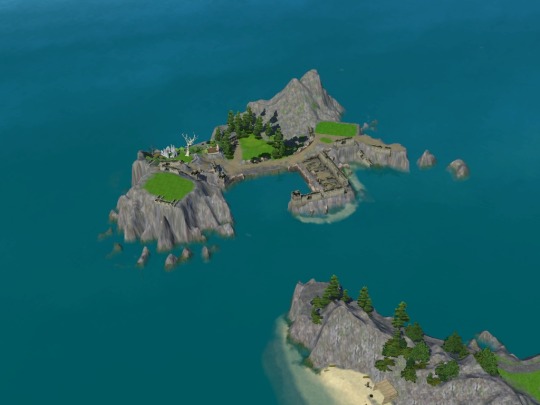
The Pirate Island is done!

so, I listened to you guys, so we get a piraty island with some spooky undertones.
Fort Lamouët is the biggest lot (even if not very interesting at the moment)
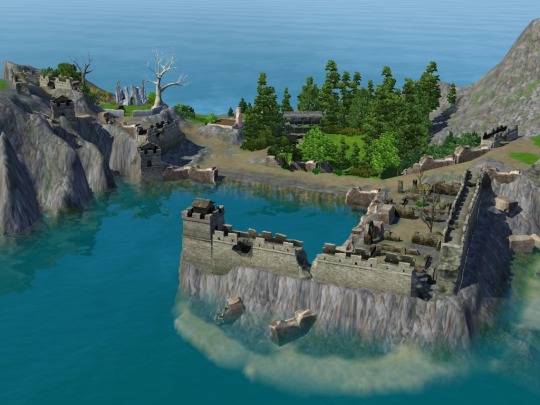
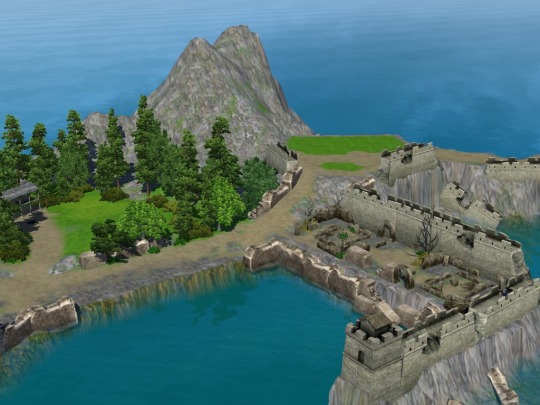
What required (and got) a burst of creativity was L'anse Houchpett, the Olde Town that may have been destroyed by the English a few centuries ago because Pirates.
The locals say this is pure slander and these people were at most civilized Corsairs... And the English are assholes anyways, so there. (Well, they're French, so...)

Anyway, the Brits did quite a good job of destroying the place.
HOWEVER, those of you who know me from TSD times will be happy to know that this place is the Lerequin birthplace... and yes, they are still around.
See, Jean Dieudonné Lerequin, somewhat famous Corsaire/Pirate/whatever of the time, hailed from L'Anse Houchpett... And there are rumors of a treasure buried somewhere.
So, anyone who knows my Lerequind will not be surprised some of them stayed put to find the treasure... and since someone has to eat in the meantime, they do cater to some tourists... and a bit more reluctantly, to some archeological digs.
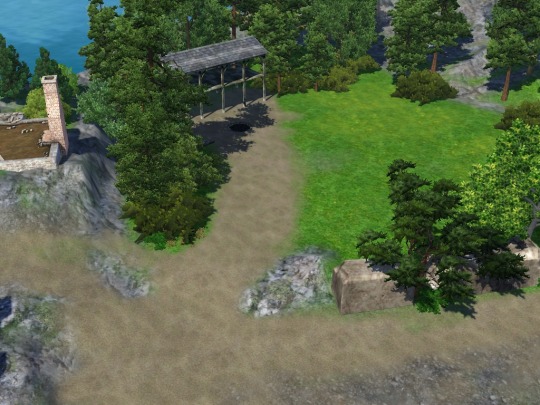
But not too much, eh?
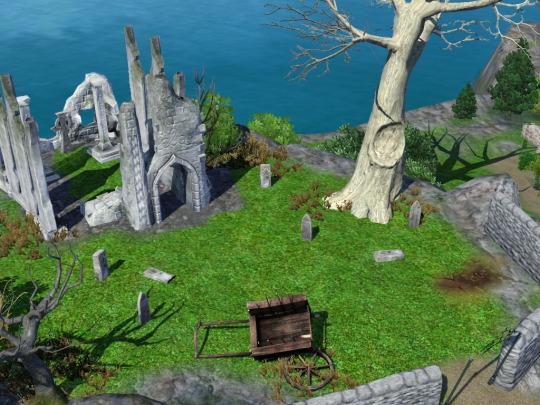
Too much curiosity could lead to a discreet fresh plot of earth in the old cementery... Well, of course in there! They are monsters, but civilized ones after all! (not to self, must add a rosebush)
Other than that, the fun parts are almost done. There's only this bit I'm not sure what to do with
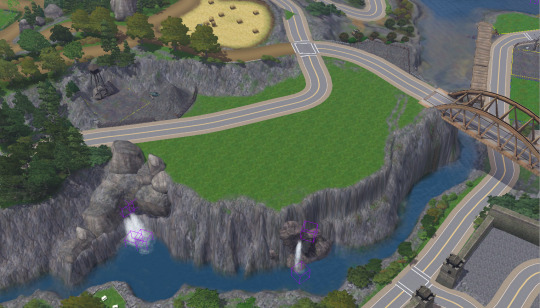
Do you guys have any ideas?
Otherwise, now is going to be details, details, details... lighting and roads signs and all the stuff like that before baggins the place... and start building!
Yeah!
39 notes
·
View notes
Text
History Blog recs
One of my Very Specific interests over the last...idk 10 years, has been reading blogs about the A Song of Ice and Fire series, by historians. I'm not sure what it is about those books: the complex, multi-layered narrative, the author's claim to work creatively with real world history, the micro-arguments contained in every arc, or what, but historians have the most FASCINATING shit to say about those books.*
I've learned so much about the logistics of civilization, the intellectual history of leadership theory, the history of subsistence agriculture, the type of agriculture needed to sustain societies of a certain size, the evolution of military theory, etc from this very specific, Historians Engage With ASOIAF and its Television Adaptations genre of blog.
There is, of course, the late great Steven Attewell's @racefortheironthrone, but I recently discovered this gem: A Collection of Unmitigated Pedantry by Dr. Bret C. Devereaux. I just finished his series analyzing, problematizing, and ultimately debunking George RR Martin's claim that the Dothraki "were actually fashioned as an amalgam of a number of steppe and plains cultures… Mongols and Huns, certainly, but also Alans, Sioux, Cheyenne, and various other Amerindian tribes… seasoned with a dash of pure fantasy."
In Part IV, he writes:
... declaring that the Dothraki really do reflect the real world (I cannot stress that enough) cultures of the Plains Native Americans or Eurasian Steppe Nomads is not merely a lie, but it is an irresponsible lie that can do real harm to real people in the real world. And that irresponsible lie has been accepted by Martin’s fans; he has done a grave disservice to his own fans by lying to them in this way. And of course the worst of it is that the lie – backed by the vast apparatus that is HBO prestige television – will have more reach and more enduring influence than this or any number of historical ‘debunking’ essays. It will befuddle the valiant efforts of teachers in their classrooms (and yes, I frequently encounter students hindered by bad pop-pseudo-history they believe to be true; it is often devilishly hard to get students to leave those preconceptions behind), it will plague efforts to educate the public about these cultures of their histories. And it will probably, in the long run, hurt the real descendants of nomads.
Which just. I LOVE EVERYTHING ABOUT IT. Y'all know how deeply concerned I am a. with the outsize influence the entertainment industry has on memory; and b. how little that industry gives a shit about responsible use of its own power. So like, this is my shit. I'm still exploring this blog and it is a TREASURE TROVE.
*I do not include myself in that grouping. My thoughts are like: BUT WHICH ONES ARE THE JEWS DANY IS MY UNPROBLEMATIC QWEEN/AZOR AHAI/PRINCE THAT WAS PROMISED/STALLION THAT'S GONNA MOUNT THE WORLD/ETC I CAN'T WAIT TIL SANSA SHOWS HERSELF IS DANY GONNA BURN IT ALL DOWN AND EMERGE FROM THE FLAMES LIKE THAT ELMO GIF IS ARYA GOING TO RIDE A WOLF WOW I DON'T CARE ABOUT BRAN I THINK THE RHOYNAR ARE THE JEWS WHERE IS THE GODDAMN FUCKING WINDS OF WINTER
**Also, I never watched more than 2 episodes of the show. I hated how it added in sexual violence and nudity for no reason when there was already PLENTY of that in the text, most of it with narrative purpose. But then I read the books because it was 2012 and I wanted to keep up with pop culture.
46 notes
·
View notes
Text
Terp/Thorp/Wierde/Warft/Værft

Most commonly known as “Terp”, by origin a Frisian word, Terps are actually known in a few places. Hang on tight, this is a long one.
The water rich lands of Dutch provinces Zeeland/Frisia (Terp) and Groningen (Wierde) - German regions Nordfriesland and Ostfriesland (Warft) and southern Denmark (Wærft) were in need of such constructions for basic quality of life.
Because the tides could freely enter the lower lands beyond the shoreline, life was to be lived intermittently. When the land was dry, sheep could graze the salt marsh. When water rose, people would retreat to the Terp.
A Terp can be made up out of a single church or farm/house to an entire small village. Concentrations of small Terps making up a village also exist. They are often surrounded by a salt marsh rampart (Kwelderwal).
Terps were made by plaggen. The top of sandy soils was taken out in little cubes, including the vegetation. The plag was then dried and compacted and stacked on top of each other, which causes an artificial hill allowing to build on.
Terp is also the Old-Frisian word which originates the Dutch word for village. Frisian culture allowed to spread because of their specialization in sheep’s wool. With most agricultural crops not being suited for salt marshes, and with the land flooded half of the day, lots of time was spent in producing high quality and highly sought after wool. This made the Frisians and especially the Terp people very rich, as seen in treasures, burials and clerical art.
Lots of Terps have been destroyed for peat mining or lost after abandonment.
Image above: Hogebeintum (Hegebeintum (Frisian), formerly known as Westerbintheim).
The largest known Terp in the Netherlands and Germany with 8,80 m above sea level.
Central is the church, on the right the historic village, the sheep pastures during floods and the encircling salt march rampart. Everything outside the rampart used to flood.
#frankish#merovingian#viking archaeology#archaeology#carolingian#charlemagne#field archaeology#viking mythology#merovingian archaeology#germanic mythology#norse mythology#anglo saxon#viking#field archaeologist#frisian#odin#vikings#germanic#germanic folklore#germanic archaeology#wodan#anglo saxon archaeology#history#jewelry#norse
36 notes
·
View notes
Text
Some Slugterra Worldbuilding
Majority of these things are based on evidence gathered from the show;
Currency:
Gold (based on the USA 1840s - 1870s Gold pieces)
Amounts; 1, 2.50, 5, 10, 20
(Source idea: 'Slugfu Showdown' when Kord and Trixie had their bet)
Government:
Each cavern has their own government systems (basically wild west style) with their own law-enforcers. High Plains has a town council whilst Logan Cavern is under the corrupted judge. The justice system does exist across the caverns similar to that of country law with the Security Slingers enforcing it.
Eastern Caverns would have a few different rules to that of the 99 Caverns
(Source: Episodes 'Mario Bravado' and 'It Comes By Night')
Environment:
Slugterra's Lumino Crystals are both a power source and are the equivalent to the sun
(Source: Slug It Out 2 Beach Cavern (so game canon lore))
Farming and Agriculture:
Using the history of colonization, its safe to suggest that when humans descended into Slugterra around 2000 years ago that they brought their livestock and farming with them. Gives explanation to the usage of meat, vegetables and fruits that wouldn’t be possible under the earth.
(Source: Mentions of Farming in 'Return of the Elementals', 'Second Chances' and 'The Fall of the Eastern Champion')
Education:
The education of Slugterra appears to be something suggested, not something enforced.
Manatory; Grades 1 through to 10 (ages 5 to 14)
Further Education: Universities and Institutes (15 and over)
(Source: "World Beneath Our Feet Part 2" and "Shadows and Light")
Workforce:
Most Slugterrians appear to take up some form of Slug Slinging as their profession or hobby. These can include;
Security Slingers, Mercenaries, Bounty Hunters, Guards, Slugball Players, Professional Slingers, Adventurers
However, there are more professions that aren’t fully based in slinging, such as;
Scientist, Mecha Engineer, Blastersmith, Technician, Train Conductor, Train/Rail Engineer, Butler/Maid, Shopkeep, Delivery Driver, Artisan, Cook/Restaurant Employee, Announcer, News Reporter, Miner, Pirate, Barkeep, Council Member, Judge, Spa Owner, Actor, Director, Cinema Worker, Racer, Farmer, Builders, Trackers, Teachers, Professors, Historians
With those in mind, more can be thought up such as;
Doctor, Vet, Musician, Cleaners, Bankers, Treasurers, Carpenters, Critics, Gardeners, Plumbers, Electricians, Fashion Designers
(Source: A majority of the character roles we see play out and mentions of professions from side cast)
#slugterra#slugterra theory#bajoterra#slugs#eli shane#slugterra eli#worldbuilding#slugterra twisted ends
81 notes
·
View notes